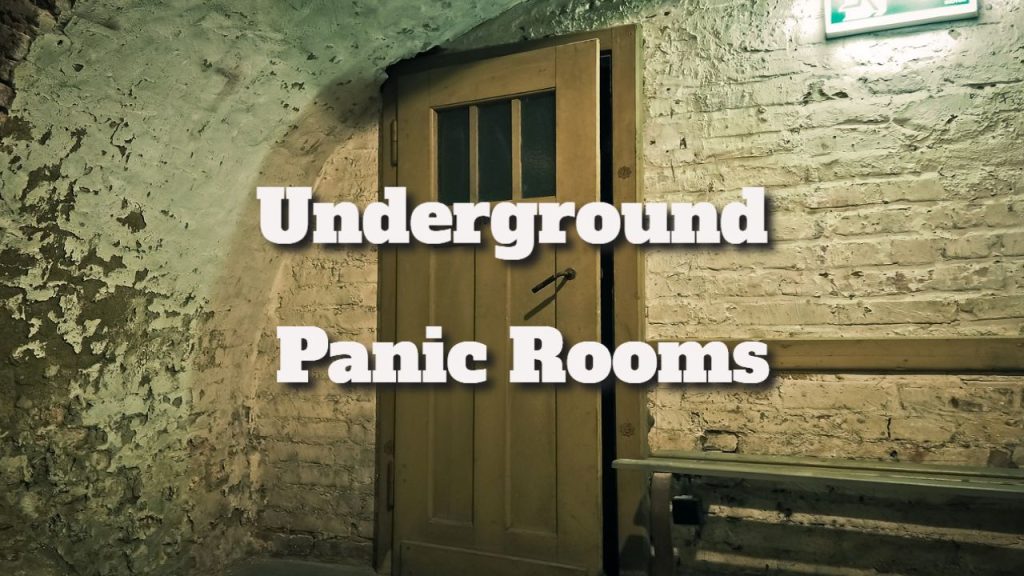Underground Panic Rooms
What would you do if a tornado struck or you needed to defend yourself from a potential threat? The urge is to seek refuge, but hiding in your basement beneath a table is not the best option!
Safe rooms are essential for overall security and purpose development since they guard against weather emergencies and security risks.
“safe room” and “panic room” are often used interchangeably. A secure panic room can also have a specific purpose, such as protecting precious things and persons against explosions or forced entry.
In this case, the panic room will be constructed with explosive mitigation in mind, including blast-proof windows, bullet-proof doors, and FP walls.
Underground Panic Rooms: What Are They?
A panic room is a purpose-built structure designed to protect individuals within. Such rooms can be constructed in private residences, government buildings, embassies, and public spaces.
When we talk about panic rooms, there are two types:
Aboveground Panic Rooms
Underground Panic Rooms
Aboveground panic rooms are frequently built at ground level to provide simple access in an emergency.
However, such rooms are ineffective during storms since flying debris can easily collapse on the room, leaving it exposed.
Similarly, above-ground panic rooms are more susceptible to criminal attacks.
On the other hand, underground panic rooms are built below ground and can easily withstand hurricanes and tornadoes.
Even in an attack or blow, most of the structure remains underground, ensuring maximum safety.
Why do you need an underground panic room?
Let's take a look at some of the reasons you need an underground panic room.
Safety
The first and most obvious benefit is that an underground panic room offers protection from inclement weather or an attack.
For example, debris can fall from any direction onto an aboveground panic room. However, it will only affect the top or entrance to an underground panic room.
Because it is built below ground, an underground panic room can give excellent safety in a big explosion!
To increase security, these structures can also be strengthened with bomb-proof windows, blast-proof doors, and even forced entry-resistant doors.
Higher Property Value
Adding an underground panic room to your home could boost its value.
Creating a secure area for your home may boost its value and serve as a selling point.
A built-in safe/panic room can be helpful, especially in places that require extreme weather protection or extra security.
Extra Storage
A panic room is designed to give protection and security during a crisis or attack, but it can also be used as extra storage space all year.
In addition to offering protection, the panic room can store objects that would otherwise take up too much space in your home!
Another advantage is that you can keep emergency supplies in your panic room.
Are safe rooms superior to underground storm shelters?
Explained
The United States has the highest annual tornado count. The United States experienced around 1376 tornadoes in 2021, up from 1075 the previous year.
The government allows safe rooms or storm shelters to protect against tornadoes and keep people safe.
Safe rooms and underground storm shelters provide the same purpose, regardless of size or location.
You may wonder if you should build a safe room or an underground storm shelter. Let's look at the distinguishing characteristics so you can make an informed decision.
Underground Storm Shelters are not flood-resistant.
Tornadoes, like rain, require a variety of weather conditions.
They form when thunderstorms reach the required pressure. Heavy rain may pour after the tornado, causing issues for underground storm shelters.
Because they are built below ground level, severe rains might create flooding and render them unusable. On the other hand, above-ground safe rooms are made of reinforced steel, giving them an edge over underground shelters.
High-speed winds do not harm underground shelters.
The location of storm shelters and safe rooms is also essential. The tornado's powerful winds have minimal effect on underground storm shelters because they are underground. Because it is underground, it protects you from high-speed debris.
Safe chambers must be constructed of reinforced steel to withstand 300 mph burrowing tornado winds and flying debris. When buying a safe room, search for FEMA certification.
Underground shelters can be hidden under rubble.
Tornadoes cause extensive damage to structures and can radically alter the environment through which they pass. It can demolish buildings and leave them in decay.
Underground shelters may be a disadvantage since they can be buried by debris and rubble quickly after the storm has passed. You could become trapped inside, forcing you to wait for assistance.
Safe rooms located above ground are less likely to be smothered by rubble. They are also more visible than the underground refuge, which may take rescuers some time to locate.
The Article Underground Panic Rooms Appeared First On Survival Avenue.
The post Underground Panic Rooms appeared first on Survival Bite.
The Article Underground Panic Rooms was found on https://limitsofstrategy.com


Comments are closed